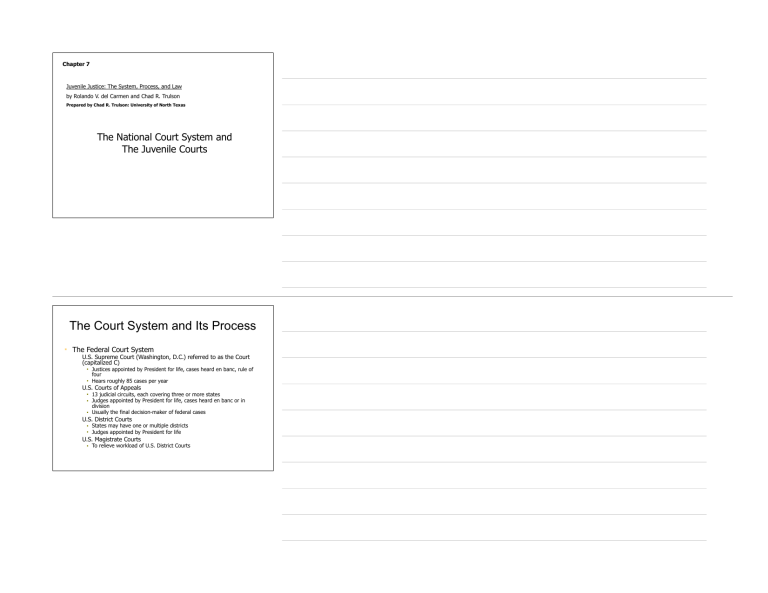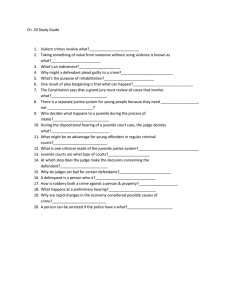
Chapter 7 Juvenile Justice: The System, Process, and Law by Rolando V. del Carmen and Chad R. Trulson Prepared by Chad R. Trulson: University of North Texas The National Court System and The Juvenile Courts The Court System and Its Process ■ The Federal Court System ■ U.S. Supreme Court (Washington, D.C.) referred to as the Court (capitalized C) ■ ■ ■ Justices appointed by President for life, cases heard en banc, rule of four Hears roughly 85 cases per year U.S. Courts of Appeals ■ ■ ■ 13 judicial circuits, each covering three or more states Judges appointed by President for life, cases heard en banc or in division Usually the final decision-maker of federal cases ■ U.S. District Courts ■ U.S. Magistrate Courts ■ ■ ■ States may have one or multiple districts Judges appointed by President for life To relieve workload of U.S. District Courts The Court System and Its Process ■ The State Court System ■ High Court: Each state has a high court, Texas and Oklahoma have two (one civil, one criminal) ■ Intermediate Appellate Courts: Most states have intermediate appellate courts General Jurisdiction Trial Courts: Below appellate courts, are trial courts In states without intermediate appellate courts, appealed cases from trial courts go directly to state’s highest court ■ ■ ■ Usually, but not always named the Supreme Court The Court System and Its Process ■ The Appeal Process ■ ■ ■ Appeals can be made to the next court in a judicial structure Appeals are primarily based on denial of defendant’s rights at trial Appeals may be: ■ ■ ■ ■ Affirmed Reversed Reversed and remand A reversal on appeal means that the person can be tried again, without violating double jeopardy The Court System and Its Process ■ The Geographical Boundaries of Court Decisions ■ ■ ■ ■ ■ ■ Most cases in juvenile justice are not decided by the U.S. Supreme Court As such, most court decisions are limited to territorial boundaries The whole country is under the jurisdiction of the U.S. Supreme Court—its rulings provide the law for the nation U.S. Courts of Appeals decisions apply to a particular circuit only. The 5th Circuit court’s decisions apply only to Texas, Louisiana, and Mississippi U.S. District Court decisions apply only to a specific district within the state State cases apply only to a particular state, and will be respected by federal courts unless the decision “offends” the Constitution The Court System and Its Process ■ The Geographical Boundaries of Court Decisions (cont…) ■ ■ ■ ■ Geographical boundaries means that conflicting rulings on juvenile justice can occur These conflicts may only be resolved with U.S. Supreme Court action The absence of Court action means that there may be different procedures and rules for juvenile justice throughout the nation Since most juvenile cases do not reach the U.S. Supreme Court, one must look to the lower courts for rules on juvenile justice The Court System and Its Process ■ Judicial Precedent (Stare Decisis) ■ ■ ■ ■ The principle that when a court has laid down a principle of law pertaining to certain facts and circumstances, it will follow the same principle in future cases, with similar facts and circumstances Abiding by decided cases sets judicial precedent U.S. Supreme Court decisions are precedent for any court in the U.S. It is the most binding kind of precedent When lower courts do not follow higher court precedent, they may be reversed on appeal The Court System and Its Process ■ Federal versus State Jurisdiction ■ ■ Federal and state jurisdictions are considered sovereign entities This means that the federal government and a state government could both try a person for the same crime without violating double jeopardy ■ ■ This applies to two or more states as well, all are considered separate sovereigns This usually does not happen, unless the person was not sufficiently punished in the first prosecution – usually in state court The Court System and Its Process ■ Juveniles in Federal Court ■ Very rare ■ There is no federal juvenile court ■ ■ ■ No federal juvenile institutions Federal law violations usually mean a violation of an identical state law ■ ■ A juvenile federal hearing would take place in front of a U.S. District judge or magistrate And will usually be tried first at state level Federal law limits juvenile prosecutions in federal court The Court System and Its Process ■ Juveniles in Federal Court (cont…) ■ Juveniles are tried in federal court only when there is a “substantial federal interest”: ■ ■ ■ ■ State does not or refuses to assume jurisdiction State with jurisdiction does not have adequate programs or services for juvenile offenders Offense is a violent felony, a drug trafficking or importation offense, or a firearms offense If a juvenile is tried in federal court, they may be waived to adult federal court The Origin and Formation of the First Juvenile Court ■ What Led Up to Juvenile Courts? ■ The culmination of several events in U.S. society ■ ■ Development of institutions for youth Houses of refuge and the adoptions of parens patriae in America ■ ■ ■ ■ Ex parte Crouse (1838) vs. O’Connell v. Turner (1870) Idea of adolescence and that children do not go from juveniles to adults overnight Restrictions on child labor Compulsory school attendance The Origin and Formation of the First Juvenile Court ■ The First Juvenile Court ■ 1899 Illinois Legislature ■ ■ ■ ■ ■ Illinois Juvenile Court Act (actual name was An Act to Regulate the Treatment and Control of Dependent, Neglected, and Delinquent Children) Child-savers: Philanthropic or not? Procedural protections were an impediment to rehabilitation “In the best interests of the child” as an avenue for abuse By 1950, every state had a juvenile court – took over 50 years from its beginning in 1899 The Juvenile Court Structure ■ Organization of Juvenile Courts ■ Juvenile courts are called by many names ■ Where juvenile courts are found? ■ ■ ■ ■ Probate, domestic relations, or family court General jurisdiction trial courts Special jurisdiction trial courts Limited jurisdiction trial courts The Juvenile Court Structure ■ Do Juvenile Courts Have Jurisdiction Over All Matters Involving Juveniles? ■ ■ ■ ■ No This is because there may be several courts that deal with juveniles in a particular jurisdiction One court may deal with serious delinquency, another court that deals with juveniles may handle dependency cases This becomes an issue with youth and their families who have multiple problems and need multiple courts to solve their problems The Juvenile Court Structure ■ Should There be a Unified or Coordinated Juvenile Court? ■ Unified Court ■ Coordinated Court ■ ■ ■ All juvenile related issues dealt with in one court by one judge Multiple courts and agencies dealing with a juvenile and his or her family could coordinate their work, for example, different judges could get together to prevent conflicting rulings Such moves would be difficult, especially unified, but some states have these types of structures The Juvenile Court Structure ■ Administration of Juvenile Courts ■ Court workload ■ Case processing ■ ■ ■ Volume or number of cases Time to hear and resolve a case once it reaches the court Case disposition ■ Time it takes for the case to get to court in the first place The Juvenile Court Structure ■ Administration of Juvenile Courts (cont…) ■ Court workload ■ ■ ■ Case processing ■ ■ ■ Roughly 2 million cases in front of juvenile courts each year (70-80% delinquency/status offense cases) Remainder dependency and neglect Judges are hurried in some jurisdictions Typical cases may last from 2-6 hours, depending on the type of case Case disposition ■ ■ A large number of juvenile cases take more than 90 days to reach the juvenile court Juveniles do not have much redress unless state law provides a remedy for slow disposition times The Juvenile Court Structure ■ Specialized Juvenile Courts ■ Teen courts ■ ■ ■ ■ ■ Dispositional in nature Diversionary in nature Deal with minor offenders, such as truancy and theft Dispositions include community service, jury duty in teen court, and counseling Youth have various stages of participation, and may even be judges, bailiffs, and attorneys The Juvenile Court Structure ■ Specialized Juvenile Courts (cont…) ■ Drug Courts ■ ■ ■ ■ ■ Can be a diversion or adjudication program Are both adjudicatory and dispositional in nature More like “regular” juvenile courts, but attempt to deal with both delinquency and substance abuse issues Youth do not play roles as judges and attorneys Very intense program with heavy judge involvement The Juvenile Court Structure ■ Juvenile Court Personnel ■ ■ ■ ■ ■ ■ ■ ■ Juvenile Court Judge Juvenile Court Administrator Juvenile Court Master or Referee Juvenile Prosecutor Juvenile Defense Attorney Youth Advocates (CASA or Guardian ad litem) Probation Officers Bottom line: the responsibilities of these court personnel are diverse. Is There a Need for a Separate Juvenile Court? ■ Abolish the Juvenile Court ■ ■ ■ ■ ■ ■ Juveniles are more responsible today for their actions Juveniles are not treated equally in the juvenile justice system The adult court can handle serious and violent juveniles more effectively The adult system could adapt to juveniles; there is no need for a duplicative system That juveniles receive the same sentences as adult, without equal procedural protections The case of the “youth discount” Is There a Need for a Separate Juvenile Court? ■ Keep the Juvenile Court ■ ■ ■ ■ ■ ■ It provides numerous helpful services that are foreign to the adult system Rehabilitation has not been lost in juvenile justice Adopting the adult system would preclude individualization in sentencing, a hallmark of juvenile justice The juvenile system does more than just sentence offenders and provides numerous helpful intervention before, during, and after adjudication and sentencing Serious and violent offenders can be waived to adult court, they are few and far between anyway The juvenile justice system is the most successful component of the entire justice system because most offenders do not come back—it makes no sense to throw it away for a few serious offenders who will not change


